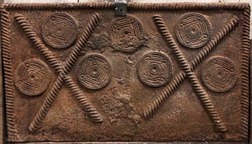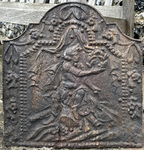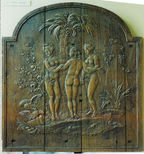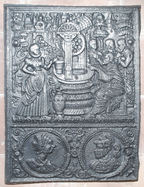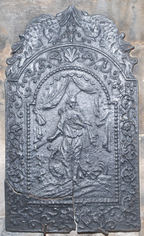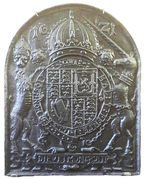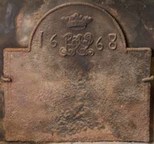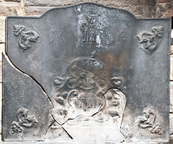-
1172
Description: Rectangular; twisted rope edging (top and sides); to each side, two saltires formed of crossed lengths of twisted rope; in between, and repeated seven times, a circular stamp decorated in low relief with a central disc perforated in the centre, surrounded by a circle inside a square looped at each corner, the sides of which are echoed twice on each side; the stamps are arranged in two rows, of three and four, in the upper part of the plate.
Notes: A boldly cast fireback with an excrescence top centre caused by disturbance of the casting sand by the pouring of the iron.
- Decoration tags:
- rectangular (shape)
- rope (edging)
- simple stamps
- carved stamps
- apotropaic
- objects
Manufactured: in the late-16th to early-17th century possibly in the Weald area of England.
Current location: Retrouvius, 1016 Harrow Road, Kensal Green, Brent, London, England.
- Attached to series:
- Food mould stamp firebacks
- Rope design firebacks
-
1253
Description: Central panel of arched rectangular shape with cavetto canted corners and bead edging; figure seated astride a triumph of weaponry (cannon, spears, drums), holding a laurel wreath in his right hand, surrounded by martial objects (flags, cannon, drums etc.), symmetrical hanging drapery above; same-shaped border with fillet edging and suspended ribbons with floral bunches
Notes: Possibly a depiction of an allegory of Victory. Other firebacks have the same distinctively shaped central panel and border shape, suggesting the same pattern maker. A reduced variant of a more elaborate fireback (no. 456) but missing mirrored serpents on top and probable reed decoration at the base.
- Decoration tags:
- rectangular with canted top corners and round arch (shape)
- fillet (edging)
- whole carved pattern
- pictorial
- humans
- plants
Manufactured: in the late-17th to early-18th century possibly in the Weald area of England.
Current location: in private hands, Kingsdown, Kent, England.
- Attached to series:
- Mayfield 'Dutch' series
- British 'Dutch' style firebacks
-
934
Description: Carved wooden fireback pattern. Arched rectangular shape with fillet and astragal edging; pictorial scene of The Three Graces in an exotic rural setting, with a palm tree, roses and ?doves.
Notes: The detail of the carving is very fine
- Decoration tags:
- rectangular with round arch (shape)
- fillet (edging)
- whole carved pattern
- planklines
- pictorial
- mythological
- humans
- plants
- objects
Manufactured: in the 18th century in France.
Current location: Haardplatenmuseum Klarenbeek, Oude Broekstraat 12, Klarenbeek, Netherlands.
- Attached to series:
- Patterns
-
356
Description: Canted rectangle; twisted rope edging (top and sides); bearded face stamp repeated in top corners and below inscription; date along top edge; initials split by date and slightly below.
Notes: The distinctive style of the ‘4’ in the date and the bearded mask stamp have also been noted on a fireback at Callow Farm, Dymock, Gloucestershire, associated with the operator of the Newent furnace.
Copies of this fireback are known.
Inscription: E 1641 M
- Decoration tags:
- rectangular with canted top corners (shape)
- rope (edging)
- carved stamps
- individual letters
- individual numbers
- text
- humans
Manufactured: in 1641 probably at Elmbridge Furnace, Newent in the Forest of Dean area of England.
Current location: Baddesley Clinton Hall, Knowle, Warwickshire, England.
Museum number: 342876 (part of the National Trust museum group)
- Attached to series:
- Miscellaneous stamp firebacks
- Date & initials firebacks
-
357
Description: Stove side plate; ovolo moulded edging; upper panel, pictorial scene of Jesus and the woman of Samaria (John: 4), with inscription below; lower panel, two circular frames, each with a figure, male to the right, female to the left, decorative scroll work between.
Notes: Stove plates were often used as firebacks once the stoves had been replaced by more efficient ones.
Inscription: VON DEN FREWLEIN VON SAMARIA IOHAN 4
- Decoration tags:
- rectangular (shape)
- flanged (edging)
- whole carved pattern
- planklines
- pictorial
- biblical
- architectural
- text
- humans
- objects
Manufactured: in the late-16th to early-17th century in the Eifel area of Germany.
Current location: Baddesley Clinton Hall, Knowle, Warwickshire, England.
(part of the National Trust museum group)
- Attached to series:
- Stoveplates
- Woman of Samaria stoveplates
-
358
Description: Arched rectangular central panel with bead edging on a broad fillet; standing on a ground with a peacock behind her, a classically-dressed figure of a female, wearing a crown and holding a sceptre in her right hand, her left hand across her chest; above her, swagged drapery; arched rectangular border with fillet edging; central scallop shell at the top with a descending arrangement of swirled and interlinked lines; at bottom centre, a cartouche bearing the letter ‘N’; on top, two mirrored serpents.
Notes: The figure is that of Hera/Juno. The pattern maker identified as ‘N’ is likely to have been working in collaboration with pattern makers whose fireback designs are identified with the initials, SHR and EB, and with the maker responsible for patterns made in 1724, some of which bore inscriptions in Welsh.
Inscription: N
- Decoration tags:
- 'Dutch' (shape)
- fillet (edging)
- whole carved pattern
- pictorial
- mythological
- text
- animals
- humans
Manufactured: in the early-18th century in England.
Current location: Baddesley Clinton Hall, Knowle, Warwickshire, England.
Museum number: 342886 (part of the National Trust museum group)
- Attached to series:
- N series
- British 'Dutch' style firebacks
-
994
Description: Arched; cavetto-moulded edging; English royal Stuart shield, garter, crown, supporters, and motto on a cartouche; a monogram of S and C lies to the left of the Garter buckle; a small rose stamp is repeated each side of crown; date split each side of top of crown.
Notes: Although English arms, the design is in a continental style, arched firebacks being typical of Lorraine. In some later recastings the proportions have been distorted, making them narrower, and the '16' of the date is missing. The fireback illustrated was formerly in the city museum of Vlissingen in the Netherlands.
Copies of this fireback are known.
Inscription: 16 21 / HONI SOIT QVI MAL I PENSE / SC / DIEV ET MON DROIT
Arms: English Stuart royal (James I)
- Decoration tags:
- rounded arched (shape)
- cavetto (edging)
- whole carved pattern
- heraldic
- monogram
- armorial
- royal
- text
Manufactured: in 1621 possibly in the Ardennes area of Belgium.
Current location: not known.
Citation: Gardner, J. S., 1898, 'Iron Casting in the Weald', Archaeologia, 56, 1, pp. 133-164.
- Attached to series:
- Jacobean royal armorial firebacks
- Stuart royal armorial firebacks
-
1156
Description: Arched rectangular shape; stylised twisted rope edging; centred, 'C & G' above 'S' above '1929', all between four stylised rope saltires.
Notes: A twentieth century fireback designed and executed in a traditional form.
Inscription: C & G / S / 1929
- Decoration tags:
- rectangular with round arch (shape)
- rope (edging)
- carved stamps
- individual letters
- individual numbers
- text
- objects
Manufactured: in 1929 in England.
Current location: Lacock Abbey, Lacock, Wiltshire, England.
Museum number: 1545478 (part of the National Trust museum group)
- Attached to series:
- Date & initials firebacks
-
1225
Description: Arched rectangular shape; twisted rope edging (top and sides); in arch, marquess's coronet above a monogram with date split either side.
Notes: The elaborate monogram has not been deciphered, but the fireback does not appear to be related to the Talbot family who owned Lacock throughout the 17th century.
Inscription: 16 [undeciphered monogram] 68
- Decoration tags:
- rectangular with round arch (shape)
- rope (edging)
- whole carved pattern
- individual numbers
- heraldic
- monogram
- text
Manufactured: in 1668 in England.
Current location: Lackock Abbey, Lacock, Wiltshire, England.
Museum number: 996713 (part of the National Trust museum group)
- Attached to series:
- Miscellaneous pattern firebacks
-
1307
Description: Rectangular shape with a flattened arch; astragal edging; top centre, stamp depicting a man and a woman in medieval dress, with inscribed date split to each side; in each corner and angled towards the corner, a triangular stamp formed of two mirrored sea serpents, their tails looped through a band, which also supports a flower rising from the serpents mouths; bottom centre, the weak impression of gadrooned vase fireback.
Notes: A bespoke fireback incorporating pseudo-antique elements, a spurious date inscribed by hand with a, probably deliberate, error in the orientation of the number 9. The 'medieval' couple and the corner stamps have yet to be identified. The impressed fireback is of the mid-17th century of the type illustrated as no. 1189.
Inscription: 16 59 [9 reversed]
- Decoration tags:
- rectangular with flattened arch (shape)
- astragal (edging)
- carved stamps
- composite
- individual numbers
Manufactured: in the late-19th to early-20th century in England.
Current location: Lindridge Place, Lamberhurst Quarter, Lamberhurst, Kent, England.
- Attached to series:
- Composite firebacks
